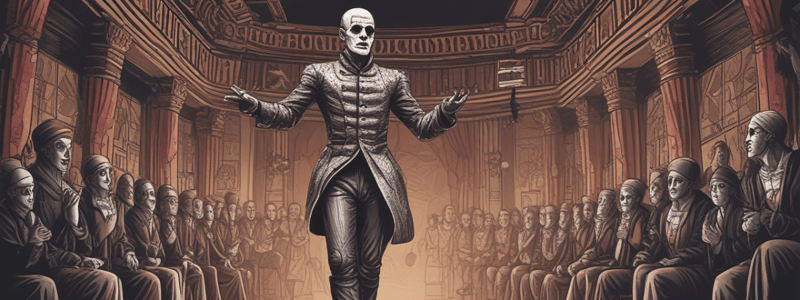Podcast
Questions and Answers
Who is considered the most famous mime artist of all time?
Who is considered the most famous mime artist of all time?
- Marcel Marceau (correct)
- Harpo Marx
- Buster Keaton
- Charlie Chaplin
What is the name of Marcel Marceau's iconic character?
What is the name of Marcel Marceau's iconic character?
- Silent Sam
- Mimmo
- Mimey
- Bip (correct)
What is the primary means of communication in mime?
What is the primary means of communication in mime?
- Body movements and gestures (correct)
- Written notes
- Verbal communication
- Facial expressions only
What is a crucial aspect of developing mime skills?
What is a crucial aspect of developing mime skills?
What is a key element of mime?
What is a key element of mime?
What is the purpose of pantomime techniques in mime?
What is the purpose of pantomime techniques in mime?
What is important to focus on when interacting with imaginary objects in mime?
What is important to focus on when interacting with imaginary objects in mime?
What is a benefit of understanding the history of mime?
What is a benefit of understanding the history of mime?
What is a goal of practicing mime techniques?
What is a goal of practicing mime techniques?
What is the ultimate goal of mime?
What is the ultimate goal of mime?
What is the main focus of mastering space and movement in mime?
What is the main focus of mastering space and movement in mime?
What is essential for effective partner mime performances?
What is essential for effective partner mime performances?
What is crucial for conveying messages and emotions in mime?
What is crucial for conveying messages and emotions in mime?
What is the primary goal of mastering basic mime techniques?
What is the primary goal of mastering basic mime techniques?
What is a key aspect of non-verbal communication in mime?
What is a key aspect of non-verbal communication in mime?
What is a vital component of non-verbal communication in mime?
What is a vital component of non-verbal communication in mime?
What do gestures primarily depict in mime?
What do gestures primarily depict in mime?
What is proxemics primarily concerned with in mime?
What is proxemics primarily concerned with in mime?
What is a key benefit of understanding body language in mime?
What is a key benefit of understanding body language in mime?
What is essential for a mime artist to become exceptional?
What is essential for a mime artist to become exceptional?
What do mimes use to define the imaginary space and establish relationships between characters or objects?
What do mimes use to define the imaginary space and establish relationships between characters or objects?
What can a mime's posture be used to depict?
What can a mime's posture be used to depict?
What is the purpose of mastering proxemics in mime?
What is the purpose of mastering proxemics in mime?
What can be created by mastering the timing and rhythm of movements in mime?
What can be created by mastering the timing and rhythm of movements in mime?
What is the fundamental aspect of mime?
What is the fundamental aspect of mime?
What can mimes achieve by refining their non-verbal communication skills?
What can mimes achieve by refining their non-verbal communication skills?
What is the primary means of communication used in mime?
What is the primary means of communication used in mime?
In which ancient civilizations was mime used as a form of entertainment and storytelling?
In which ancient civilizations was mime used as a form of entertainment and storytelling?
Who is credited with pioneering modern mime techniques and principles?
Who is credited with pioneering modern mime techniques and principles?
What era saw the rise of modern mime as a distinct art form?
What era saw the rise of modern mime as a distinct art form?
What was the focus of Etienne Decroux's modern mime techniques?
What was the focus of Etienne Decroux's modern mime techniques?
What was the primary aspect of mime explored by Jean-Louis Barrault?
What was the primary aspect of mime explored by Jean-Louis Barrault?
What style of theater emerged during the Renaissance period in Italy and heavily relied on mime?
What style of theater emerged during the Renaissance period in Italy and heavily relied on mime?
In which ancient Greek context was mime used to convey emotions and communicate with the audience?
In which ancient Greek context was mime used to convey emotions and communicate with the audience?
Flashcards are hidden until you start studying
Study Notes
History of Mime
- Mime is an ancient art form that uses body movements, gestures, and facial expressions to convey emotions, actions, and situations.
- Mime has been practiced by various cultures throughout history, including ancient Egypt, Mesopotamia, and Ancient Greece.
- In ancient Greece, mime was an integral part of theatrical performances, used to communicate with the audience and convey emotions.
- During the Renaissance, Commedia dell'arte emerged in Italy, relying heavily on mime to portray characters and comedic situations.
The Rise of Modern Mime
- In the 19th and 20th centuries, mime started to gain recognition as a distinct art form.
- Artists such as Etienne Decroux and Jean-Louis Barrault pioneered modern mime techniques and principles.
- Decroux focused on the physicality of movement and the expressiveness of the body.
- Barrault emphasized the psychological aspects of mime and explored the connection between the performer and the audience.
Marcel Marceau and Contemporary Mime
- Marcel Marceau developed his own unique style of mime, known as "pantomime," which combined elements of movement, gesture, and facial expressions.
- In recent years, mime has continued to evolve and adapt to modern times, incorporating new technologies and exploring different genres.
Basic Mime Techniques
- Body control and awareness are crucial for mime, involving understanding how various body parts can be manipulated to convey different emotions and actions.
- Facial expressions are a key element of mime, used to communicate emotions and ideas.
- Gestures and body language are essential for conveying actions and intentions without words.
- Pantomime techniques, such as opening an invisible door or climbing an imaginary ladder, tell a story or engage in an activity through exaggerated movements and gestures.
Creating Invisible Objects and Partner Mime
- Mime artists can create the illusion of interacting with imaginary objects by using precise movements and mimicking the weight and texture of an object.
- Partner mime involves working with another person to tell a story or act out a scene, requiring communication and anticipation between partners.
Understanding Non-verbal Communication in Mime
- Non-verbal communication is essential in mime, relying on body language, facial expressions, eye contact, gestures, proxemics, posture, and timing and rhythm.
- Body language refers to the movements and positions of the body that convey meaning without the use of words.
- Facial expressions indicate emotions, thoughts, and intentions.
- Eye contact helps establish a connection between the mime artist and the audience.
- Gestures depict objects, actions, and interactions.
- Proxemics refers to the use of space and distance in communication.
- Posture conveys character traits, emotions, and intentions.
- Timing and rhythm are crucial elements in non-verbal communication, creating dramatic effects and conveying a sense of rhythm and flow.
Studying That Suits You
Use AI to generate personalized quizzes and flashcards to suit your learning preferences.




